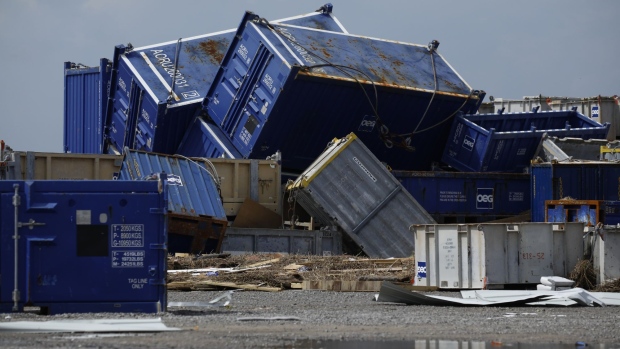Sep 2, 2021
Ida’s Wake Leaves Toxic Chemicals, Sewage Swirling in Louisiana
, Bloomberg News

(Bloomberg) -- Exxon Mobil Corp. released sulfur dioxide and hydrogen sulfide at its Baton Rouge refinery as Ida churned ashore. A broken pipeline poured crude oil near a bayou that flows to the Gulf of Mexico. And a miles-long black slick has appeared near an offshore rig off the state’s coast, stirring fears of a spill.
Days after the hurricane swept through the area, the environmental aftermath is emerging in a petrochemical corridor packed with hazardous-chemical plants and refineries.
In some areas, the chemicals are mixing with raw sewage released from treatment plants that lost power.
“It looks like there is widespread pollution,” said Naomi Yoder, a staff scientist with Healthy Gulf, a nonprofit environmental group.
Nearly 100 spills and other incidents had been reported to the Louisiana Department of Environmental Quality as of Thursday afternoon, raising concerns among environmentalists and public health officials about toxic discharges.
Among the chemicals released was anhydrous ammonia from two storage tanks at a CF Industries fertilizer facility near the Mississippi River in Donaldsonville, Louisiana, according to the state agency. A CF Industries spokesman said the issue was resolved and that there had been no off-site impacts.
Exxon said in a statement that the release from its Baton Rouge facility “was quickly isolated and contained to the unit” and that chemical readings are now below detection limits.
A Koch Industries Inc. subsidiary, Koch Nitrogen, also reported a release of the highly toxic, colorless gas at a site near the Mississippi.
Phillips 66 reported that two separate pipelines were leaking hazardous propylene and isobutane in St. Charles Parish. And the U.S. Environmental Protection Agency said it was in touch with Royal Dutch Shell Plc about its Norco refinery due to “excessive smoke seen in the community.”
Representatives of Koch and Phillips 66 didn’t immediately respond to a request for comment.
Raw sewage has also been released. A “complete power failure caused 95% of lift stations to fail” in New Orleans’ Jefferson Parish sewer system, resulting in a release of hundreds of thousands of gallons of wastewater, according to the Louisiana DEQ.
“Our entire sewage system operates on electricity,” said Mike Lockwood, director of the Jefferson Parish Department of Sewage.
In neighboring Alabama, the state’s Department of Environmental Management reported flooding from the storm caused tens of thousands of gallons of untreated sewage to be released in the state.
“Sewage overflows are a serious threat to public health and our ecosystems,” said John Rumpler, a senior director with the group Environment America, “Pathogens in our waterways make millions of people sick every year.”
The Louisiana DEQ also received several reports of oil-like sheens in the water, and a spokesman, Greg Langley, said it would be assisting the Louisiana Oil Spill Coordinator’s Office to investigate reports of a miles long slick near an offshore rig in the gulf. The Bureau of Safety and Environmental Enforcement said it was investigating.
Flooding and other damage from Ida, which packed some of the most powerful winds ever to hit Louisiana, caused widespread power outages that have hindered officials’ ability to access the impact. The Louisiana DEQ said it was being hampered by communications problems following the storm and that a number of its air quality monitoring stations had been knocked offline with power.
“Everyone is strained to their breaking point right now,” said Patrick Courreges, a spokesman for the Louisiana Department of Natural Resources.
©2021 Bloomberg L.P.


